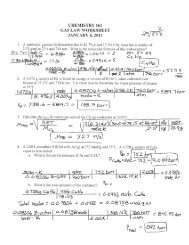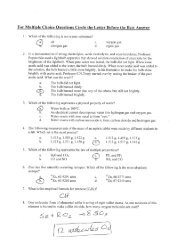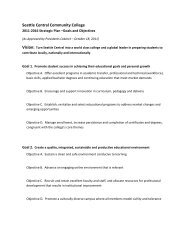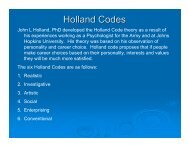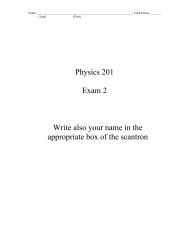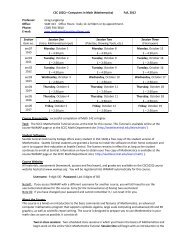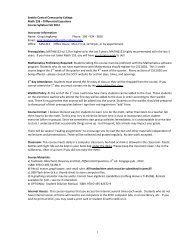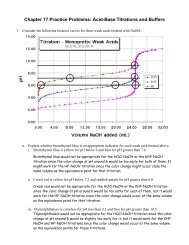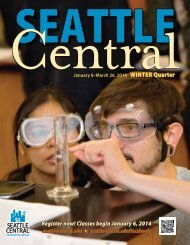Biology 241 - Seattle Central Community College
Biology 241 - Seattle Central Community College
Biology 241 - Seattle Central Community College
Create successful ePaper yourself
Turn your PDF publications into a flip-book with our unique Google optimized e-Paper software.
<strong>Biology</strong> <strong>241</strong>: Human Anatomy and Physiology ICourse Schedule: Mondays and Wednesdays 5:30 – 9 pm (SAM Rooms 105 and Lab 306)Instructor:Dr. Anna DavisEmail:adavis@sccd.ctc.eduOffice: SAM 321Phone:516-3125 (best to reach me via email)Office Hours: By appointmentCourse Website: http://www.seattlecentral.edu/faculty/adavis/ and ANGEL course site (You will receiveinstructions Class 1)PREREQUISITES:Required: 1) English language competency2) Successful Angel LOGIN(You can access Login Instructions athttp://www.waol.org/getStarted/findClassroom.asp)Recommended: 1) <strong>College</strong> Chemistry (introductory, 121)2) <strong>College</strong> <strong>Biology</strong> (introductory, 160)3) Eligibility for Math 084 and English 101COURSE DESCRIPTION:Human Anatomy and Physiology (ANP) <strong>241</strong> is the first class in a two quarter sequence in which humananatomy and physiology are studied using a body systems approach with emphasis on the interrelationshipsbetween form and function at the gross and microscopic levels of organization. You can think of this courseas “An Owner’s Guide to the Human Body”. My goal is to help you learn how your body works so that you canexplain concepts to others and apply knowledge to novel situations (make informed decisions regarding yourown health and those whom you care about). You’ll also learn how to evaluate the scientific research thatforms the basis of our understanding of human anatomy and physiology and gain an appreciation for whatremains to be discovered. To accomplish these goals requires significant effort from both of us. Althoughyou will need to commit information to memory, I will ask you to focus on learning for understanding andyour assessments will reflect this emphasis.Topics we cover include: basic anatomical and directional terminology; review of basic chemistry; study of:fundamental concepts and principles of cell biology and cell physiology, tissues (histology), integumentary,skeletal, muscular, cardiovascular, immune and respiratory systems; and, unifying themes of homeostasis,health and disease.You will also gain experience problem solving, interpreting data, communicating verbally and in writing withothers, developing information literacy skills, using technology and exploring how your knowledge ofanatomy and physiology can be applied to real world health challenges. This course is designed to build the
core knowledge and skills needed to succeed in a world that demands flexibility and continuous learning andto prepare you for advanced study of anatomy, physiology and clinically-related subjects.REQUIRED TEXTS/MATERIALS:Fundamentals of Anatomy and Physiology, by Martini and Nath, Prentice Hall, 8 th edition.Exploring Anatomy and Physiology in the Laboratory by Ammerman, Morton Publishing Company***Additional Support Materials: Online course materials will be provided via ANGEL, PhysioEX, Histologyand Anatomy Atlases. All of you have access to additional support materials by registering with yourtextbook at http://www.aw-bc.com/myaandp/booksAvail.htmlCOURSE LEARNING OBJECTIVES*:General Objectives1. Develop a vocabulary of appropriate terminology to effectively communicate information related toanatomy and physiology.2. Recognize the anatomical structures and explain the physiological functions of body systems.3. Recognize and explain the principle of homeostasis and the use of feedback loops to control physiologicalsystems in the human body.4. Use anatomical knowledge to predict physiological consequences, and use knowledge of function to predictthe features of anatomical structures.5. Recognize and explain the interrelationships within and between anatomical and physiological systems ofthe human body.6. Synthesize ideas to make a connection between knowledge of anatomy and physiology and real-worldsituations, including healthy lifestyle decisions and homeostatic imbalances.7. Demonstrate laboratory procedures used to examine anatomical structures and evaluate physiologicalfunctions of each organ system.8. Interpret graphs of anatomical and physiological data.Specific ObjectivesA. Body Plan & Organization: Understand the scope of studies in anatomy and physiology and be able touse and understand descriptive anatomical and directional terminology.B. Homeostasis: Explain the basic concept of homeostasis and how homeostatic mechanisms apply to bodysystems. Homeostasis is a unifying theme and will be examined in all modules of study.C. Chemistry Review: Basic understanding of structure of atoms and biologically relevant molecules(inorganic compounds, organic molecules, ATP),D. Cell <strong>Biology</strong> Review: Identify cellular structures and explain their respective functions.E. Tissues/Histology Describe the basic tissues of the body and their location and explain their functions.F. Integumentary System: Identify and describe the major gross and microscopic anatomical componentsof the integumentary system and describe the functions of the system.G. Skeletal System & Joints: Identify and describe the major gross and microscopic anatomicalcomponents of the skeletal system and explain their functional roles in osteogenesis, repair, and bodymovement.H. Muscular System: Identify and describe the major gross and microscopic anatomical components ofthe muscular system and explain their functional roles in body movement, maintenance of posture, and heatproduction.I. Cardiovascular System: Identify and describe the major gross and microscopic anatomical componentsof the cardiovascular system and explain their functional roles in transport and hemodynamics (blood, bloodvessels, heart).J. Lymphatic System & Immunity: Identify and describe the major gross and microscopic anatomicalcomponents of the lymphatic system and explain their functional roles in fluid dynamics and immunity(innate, acquired).
K. Respiratory System: Identify and describe the major gross and microscopic anatomical components ofthe respiratory system and explain their functional roles in breathing/ventilation and in the processes ofexternal and internal respiration.*Adapted from HAPS Learning Outcomes Project, 2010COURSE DETAILS (Keys to Success)Instructional Delivery: This is an ANGEL supported class with content divided into modules of study aligned todifferent body systems. Twice weekly face-to-face meetings will be devoted to group discussions/presentations,laboratory work and in-class assessments of new material and sometimes traditional lecture. Laboratory exercisesinclude hands-on work with tissues, microscopes, models, and organs and where appropriate use of human subjects(students) for physiology experiments.Online course materials will include: text readings, written study questions, thought provoking discussion boardtopics, written laboratory preparation activities, and active learning activities including exploration of global issueslinked to health and disease (e.g. air quality and respiratory disease, lifestyle and cardiovascular disease, etc.).Assignments: Student assignments will be submitted via the Angel drop box linked to each assignment unlessotherwise specified.Lectures/Class Meetings: Lectures and in-class exercises emphasize content that you will be required to learn.The textbook and online materials will support and supplement the material covered in class. It is good practice toread the text before the topic is discussed in class and come to class with your questions. Pre-lecture assignmentsmust be completed and submitted before lecture.Labs: Weekly lab exercises must be completed during the scheduled lab sessions on Monday and Wednesdayevenings. Attendance in lab is mandatory. Pre-labs must be completed and submitted prior to lab.After the first week of the quarter, there are open labs supervised by tutors where you can have additional timewith lab models (e.g. bones), histology slides.Angel: Our Angel website contains the course calendar, content, discussion board, assignment drop boxes.are required to check the course the website daily throughout the quarter.YouStudent Responsibilities: You are expected to:check the class ANGEL site dailyturn in assignments on time (posts to discussion board, homework, quizzes) either in class or via the ANGELdrop-box,attend every class session. If you miss a lecture, then it is your responsibility to obtain the lecture notes,assignments, and materials handed out in class. If you must miss class due to a prolonged illness orunexpected circumstance, you should notify the instructor as soon as possible to make arrangements.participate as a fully engaged member for all group work (e.g. in lab)respond to any course emails within 24 hours throughout the quarter. Participation means being preparedand engaged as an eager learner in class, during lab, online and as an equal partner during groupproject work.Commitment/Study Suggestions: This course covers a lot of material in a short period of time therefore itrequires a strong commitment in order to succeed. Plan to attend every class and spend at least 2 hours outsideof class for each hour spent in class therefore you should expect to spend a minimum of 10 additional hours perweek studying. Your studies outside of class should include reading and studying your lecture notes, the onlinecourse materials, answering study questions, participating in group discussions (provide thoughtful analyses of
questions posed) and studying laboratory materials (microscope slides, models, etc.). Many successful students(3.5 – 4.0) form study groups and communicate regularly with their teacher.Need help?Communicate with the Instructor: Please ask for help early and often if you are struggling.During this course, my top priority is to help you understand Anatomy and Physiology. If you have any questionsthroughout the quarter please contact me immediately: in person during class, via the ANGEL Discussion Board,via ANGEL email or adavis@sccd.ctc.edu . Additionally, you can make an appointment to meet with me privatelyoutside of class. This is YOUR learning experience and I am here to support you! You should expect an emailresponse from me within 24 hours to a direct question or post to our Discussion Board (Monday-Friday). Pleasenote that I will not respond to every message sent to the Discussion Board but I will facilitate the discussionthreads so that learning objectives are met. You should expect to receive your critiqued and graded work within72 hours of the assignment deadline unless I post a message indicating otherwise.Additional Help: Tutors will be available in OPEN Lab to provide additional support (Days/Times TBA). Additionaltutors are available in the Science and Math Resource Center (SAM 100). Anatomical models are available in thelibrary.Special Assistance: Please let me know if there are any additional areas that you will need assistance includingphysical access to the classroom or laboratory, ASL interpreters, or extra time to take an exam. If you arephysically or learning challenged, please let me know at the start of the class so that steps can be taken to makethe learning environment as comfortable and successful as possible. If you need special arrangements in case thebuilding must be evacuated, please contact me. Counselors are available to assist you. You may make an appointmentthrough the Science and Math Division Office, Room 110 or contact Counselor Stephen Simeona via email:ssimeona@sccd.ctc.edu.EvaluationAcademic Honesty: The worst academic offenses are cheating and plagiarism. All exams and quizzes areindependent works of the individual student. Please make sure you understand the definition of plagiarism asdefined here: http://www.wpacouncil.org/node/9. The consequences for cheating and plagiarism can be as seriousas failing the course, and in some instances, being kicked out of school.Assessment Method Point Value % Points3 Exams 100 pts 40% 4001 Final Exam 200 pts 20% 2005 (Weekly) Quizzes 20 pts 10% 10010 (Weekly) Homework 15 pts 15% 150Assignments (e.g. studyquestions, discussionboard posts, minipresentations,pre andpost labs)1 Group Project 100 pts 15% 100Participation 50 pts 5% 50TOTAL = 1000
Tests (Exams/Quizzes): There will be 4 exams. These tests are designed to assess your understanding ofanatomy and physiology and are likely to include a mix of multiple choice, short answer and essay style questions aswell as identification of structures studied in lab (e.g. cell structure and tissue histology, organ structure (heart)etc.)The approximate dates of tests are listed in the course schedule.There are no early, late, or makeup tests and no extra time is given for those arriving late to an exam.Quizzes are not cumulative and are designed to take approximately 15 minutes.All 4 exams including the final are cumulative with emphasis on the most recent material covered exceptfor the final.Exam/Quiz Reflections: As part of this course you will be required to submit corrected responses to anymissed exam/quiz questions and a brief reflection on why you missed the question (rubric will be provided).If there is a mistake on the addition of your exam, please return it to your instructor immediately for areassessment. If you are unsure/unhappy with the grading protocol, turn in a written explanation of theareas in question no later than one week after the exam has been returned.Homework (Discussion Board posts/Assignments, etc.): There will be weekly homework assignments associatedwith each module (e.g. discussion board reflections, study questions, etc.). All homework must be submitted ontime (in class or to the drop box associated with the assignment). Late homework will receive no credit.Group Project: On the second week of the quarter you and several peers will chose a body system to explore inhealth and disease. During the last week of the quarter, you will share your organ system presentation orally (10 –15 minute presentation) and in writing (3 page maximum). Detailed project guidelines will be provided.Grading/Assessment Policy: The final grade for this course will be a combination of your assessment scoresaccording to the rubric shown above. Dates for assessments are listed in the tentative schedule but note that theinstructor reserves the right to alter the schedule, assignments, grading procedures, etc., at any point in timeduring the class, due to schedule conflicts, new/different assignments, new approaches, etc., based upon theinstructor’s professional judgment.Course Grade: Grades will be tentatively assigned as follows and follow the standards set by <strong>Central</strong> <strong>Seattle</strong><strong>Community</strong> <strong>College</strong>:4.0 = 95% 3.4 = 89% 2.8 = 79% 2.2 = 70% 1.6 = 61% 1.0 = 52%3.9 = 94% 3.3 = 88% 2.7 = 78% 2.1 = 69% 1.5 = 60% 0.9 = 50%3.8 = 93% 3.2 = 85% 2.6 = 76% 2.0 = 68% 1.4 = 59% 0.8 = 48%3.7 = 92% 3.1 = 83% 2.5 = 74% 1.9 = 66% 1.3 = 58% 0.7 = 46%3.6 = 91% 3.0 = 81% 2.4 = 73% 1.8 = 64% 1.2 = 56% 0.6 = 44%3.5 = 90% 2.9 = 80% 2.3 = 71% 1.7 = 62% 1.1 = 54% 0.5 = 42% etc.Technology Access/Skills Required:Minimum suggested technology access includes the following:Access to a computer (at home, school, or work) which you can use for extended periods of time.Broadband internet access (cable modem, DSL, or other high speed).Firefox 3.0 or later or Internet Explorer 7 or later. Safari and Chrome are not compatible with Angel.Failsafe back-up for course work: Memory stick, external hard-drive, or google docs, etc.Permissions/ability to install plug-ins or class software (e.g. Adobe Reader or Flash)Highly recommended: up-to-date anti-virus softwarereview the System Check nugget on the Angel home page.Minimum technical skills include ability to:
Navigate web sites (download and read files from web sites)Download and install software or plug-ins such as Adobe Reader or FlashUse email, including attaching and downloading documents/files from emailsSave files in commonly used word processing formats (.doc, .docx, .rtf)Copy and paste text and images on a computerSave and retrieve documents and files on your computerLocate information on the internet using search enginesRead, understand and agree to adhere to “netiquette” in all course communication as articulatedhere: http://www.online.uwc.edu/Technology/onlEtiquette.aspOther Information:Inclement Weather: Please sign up to receive Campus Alerts: https://alert.seattlecolleges.edu/LogIn.aspxLibrary Resources - http://dept.sccd.ctc.edu/cclib/Technology Help: http://seattlecentral.edu/it-services/student/index.phpStudent Support Services: http://www.seattlecentral.edu/academic-assistance/index.php .WINTER QUARTER 11 (56 instructional days)Jan. 4WINTER QUARTER BEGINS.Jan. 10 Last day to withdraw with 100% refund (less $5).Jan. 18Last day to add/register; instructor permission required. Last day to change audit/credit status withoutinstructor permission. Last day to withdraw without a "W" appearing on transcript and without instructorpermission.Jan. 24 Last day to withdraw with 50% refund; instructor permission required.Feb. 25 Last day to withdraw (no refund) or change audit/credit status; instructor permission required.Mar. 23 WINTER QUARTER ENDS.Mar. 29 Grade Deadline (9:00 p.m.)Mar. 30 GRADES AVAILABLEStudents who stop attending class and do not initiate one of the following alternatives will receive a grade of0.0. Please take note of the following:I - Incomplete. Given only to students who perform at a passing level (60%) but did not complete a smallportion of the course requirements and wish to complete the course next quarter. Given at the instructor’sdiscretion.N - Audit. Requires official registration.NC - No Credit. Student did not fulfill the course requirements. If the overall student performance is60% or better, a student may request an NC from the instructor PRIOR to the final exam. This grade isgranted at the instructor's discretion.
Tentative Schedule <strong>Biology</strong> <strong>241</strong>Week Dates Topics Text Lab1 1/3 – 1/7 Introduction,2 1/10 – 1/14Quiz1 (1/10)HomeostasisChemistry Review, CellStructure, CellPhysiologyCh 1, Ch2Ch 3ANGEL access and Lab SafetyOrgan Systems ExplorationAnatomical TermsMicroscope Use, Cell Structure and PhysiologyTransport and TissuesTissues Ch 43 1/17 – 1/21Holiday (1/17)HOLIDAY Ch1 - 5 Tissue, Introduction to Organs: SkinSkin: Integument Ch 5System4 1/24 – 1/28EXAM 1 (1/24)Exam 1 andIntroduction toSkeletal SystemCh 6Skeletal SystemBone PhysiologySkeletal System Anatomy5 1/31 – 2/4Quiz2 (1/31)Skeletal System Ch 7,Ch 8Articulations Ch 9 Chicken Leg DissectionMuscular System: PhysiologyMuscular System Ch 106 2/7 – 2/11Quiz3 (1/31)Muscle Ch 10and 11Muscle Ch 11Muscular System: Anatomy7 2/14 – 2/18EXAM 2 (2/14)EXAM 2 andCardiovascular SystemCardiovascularSystem: HeartCh 19Ch 20Heart DissectionEKGBP Measurement8 2/21 – 2/25Quiz4 (2/21)9 2/28 – 3/4Quiz5(2/28)Heart Ch 20 Blood AnalysisVessel AnatomyVessels andCirculationCh 21Respiratory System Ch 15 Respiration: Anatomy, Respiratory Volumes10 3/7 – 3/1Exam 3 (3/7)Exam 3 and Blood,Immune SystemImmune SystemBlood and ImmuneSystemCh 19,Ch 2211 3/14 – 3/18 Group Projects and ALL Review and Group Presentations
Tentative Schedule <strong>Biology</strong> <strong>241</strong>Week Dates Topics Text LabReview12 3/21: FinalExamFINAL Exam: Monday3/21



